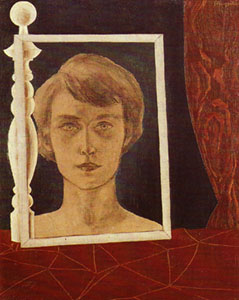Hi,
This blog we'll look at one of Magritte's lesser known paintings, his portrait of Georgette with Bilboquet from early 1926.

Georgette with Bilboquet Jan. 1926
This is one of the early paintings using one of Magritte's favorite icons, the bilboquets or balluster. It's also an early example of another of Magritte's common settings- it is a painting within a painting.
At first I thought the ballusters or "bilboquets" as Magritte called them were wooden dowls put on a lathe that resembled table legs or bed posts. Then remembering Magritte was an avid chess player the "bilboquets" looked like the bishop of a chess set. According to one source: A little like mannequins in the work of Giorgio de Chirico, these biboquets that Max Ernst called "phallustrade" signify the erection of the mysterious, the desire that the invisible - retired in to itself - has to be seen. The mystery of Being concerns us, encircles us and calls us towards it. The retreat of Being atrracts us, it is our first pre-occupation and regards us before the secondary regard that we turn toward it when we are guided by resemblance. The picture resembles Being as Being, in the measure that the painting assembles or directs our view upon the regard, the regard that comes from Being and is not invented by us.
This small portrait of Georgette as a picture within a picture, painted in the first weeks of 1926, the bilboquet standing on the table is partly within the painting/photo- an impossibilty. There is another famous icon on the right; the curtain.
In 1960 Magritte in response to a questionairre talked about his famous object of mystery, the "bilboquet."
Question: Why is it that in some of your paintings bizarre images appear like the Bilboquet?
Magritte: I don't think of a bilboquet as being bizarre. It's rather something very banal, as banal as a pencil holder, a key or teh foot of a table. I never show bizarre or strange things in my paintings... not bizarre but ordinary things that are gathered and transformed in such a way that we're made to think that there's something else of an unfamiliar nature that appears at the same time as the familiar.
In some paintings the bilboquets are trees at other times they are human, surely they are mysterious beings. In Georgette with Bilboquet, the bilboquet stands like a sentry both in front and behind her. Personally I think it's a subconscious joke Magritte was playing without even realizing...it's a bishop.
Your move Rene.